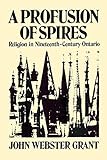A Profusion of spires : religion in nineteenth-century Ontario.
Material type: TextSeries: Ontario historical studies seriesPublication details: University of Toronto Press, ©1988.Description: 1 online resource (x, 291 pages, 18 unnumbered pages of plates)Content type:
TextSeries: Ontario historical studies seriesPublication details: University of Toronto Press, ©1988.Description: 1 online resource (x, 291 pages, 18 unnumbered pages of plates)Content type: - 9781442670419
- 144267041X
- Religious thought -- Ontario -- 19th century
- Ontario -- Religion -- 19th century
- Ontario -- Church history -- 19th century
- Pensée religieuse -- Ontario -- 19e siècle
- Ontario -- Religion -- 19e siècle
- Ontario -- Histoire religieuse -- 19e siècle
- HISTORY -- Canada -- General
- RELIGION -- Comparative Religion
- Religion
- Religious thought
- Ontario
- Religion
- Ontario
- 1800-1899
- Geschichte 1800-1900
- Ontario Religions, history
- 291/.09713 19
- 209/.713 19
- BR575.O5 G73 1988
- online - EBSCO
- digitized 2010 HathiTrust Digital Library committed to preserve
| Item type | Current library | Call number | URL | Status | Notes | Barcode | |
|---|---|---|---|---|---|---|---|
 eBook
eBook
|
Biblioteca "Angelicum" Pont. Univ. S.Tommaso d'Aquino Nuvola online | online - EBSCO (Browse shelf(Opens below)) | Online access | Not for loan (Accesso limitato) | Accesso per gli utenti autorizzati / Access for authorized users | (ebsco)682374 |
Use copy Restrictions unspecified star MiAaHDL
Electronic reproduction. [Place of publication not identified] : HathiTrust Digital Library, 2010. MiAaHDL
Master and use copy. Digital master created according to Benchmark for Faithful Digital Reproductions of Monographs and Serials, Version 1. Digital Library Federation, December 2002. MiAaHDL
http://purl.oclc.org/DLF/benchrepro0212
digitized 2010 HathiTrust Digital Library committed to preserve pda MiAaHDL
Print version record.
Contents -- The Ontario Historical Studies Series -- Preface -- 1 Spirits of the Land -- 2 Uprooted Traditions -- 3 Foundations -- 4 Varieties of Pioneer Religion -- 5 Atlantic Triangle -- 6 Religion on the Hustings -- 7 New Measures -- 8 Echoes of Europe -- 9 Affairs of State -- 10 Mission Accomplished -- 11 The Activist Temper -- 12 The Beckoning Vision -- 13 Strains in the Fabric -- 14 The Anatomy of Ontario Religion -- Notes -- Picture credits -- Index -- A -- B -- C -- D -- E -- F -- G -- H -- I -- J -- K -- L -- M
No -- p -- q -- r -- s -- t -- u -- v -- w -- y -- z
In their heyday, Ontario's churches were the acknowledged arbiters of acceptable belief and respectable behaviour. Denominational affiliation was a key factor in determining whom people married, what colleges they chose for their children, how they voted, and in some cases what they wore. The central role of religion in provincial life did not spring spontaneously from the pious inclinations of settlers; it was carefully planted and nurtured by missionaires from Britain and the United States. Theirs was a continuing struggle, beset with relics of frontier barbarism on one hand and the preoccupation with material pogress on the other. Their dominant position had scarcely been won when it began to be threatened by the emergence of new social and intellectual patterns. But the roots still run deep: even today one only has to propose changes in the school system or in Sunday-retail legislation to discover how deeply the chuches have shaped provincial assumptions and attitudes. John Webster Grant traces the development of religion in Ontario from before the arrival of European settlers until the end of the nineteenth century. Here we meet sober (and not so sober) representatives of the 'three churches' of England, Scotland, and Rome, fervent Methodist saddle-bag preachers, plain Mennonites and Quakers, colourful Children of Peace, and many others. We follow the course of conflicts and controversies that arose from different views of the appropriateness of government aid to churches or their educational institutions. We see Ontarians trying to change the world or to maintain ancestral folkways, in either case for religious reasons. Above all, we are given a picture of what it meant to be religious in Nineteenth-century Ontario, and a clearer understanding of controversies still bitter today.


